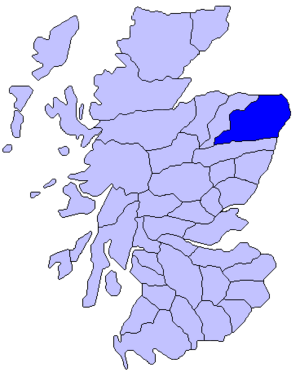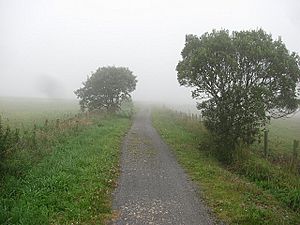Beast of Buchan facts for kids
Have you ever heard of a mysterious big cat roaming the Scottish countryside? In Scottish folklore, the Beast of Buchan is a large, wild cat that many people say they have seen. It's often described as a "phantom cat" because it's so hard to find. Most sightings happen in the historic Buchan area of Aberdeenshire in northeastern Scotland. But people have also reported seeing it across other parts of Scotland, from the northern highlands down to the border with England. The first stories about this creature go back to the 1930s.
What is the Beast of Buchan?
People have reported seeing the Beast of Buchan since the 1930s. But stories about large, wild cats in Britain are much older. For example, a writer named William Cobbett described seeing a cat the size of a medium dog in the 1760s. He thought it looked like a Canada lynx.
In the UK, there are two types of wild cats: domestic feral cats and wildcats. However, many reports describe cats much larger than these. In 2006, a survey found about 6,000 sightings of unusual cats in just five years. Some people even think there could be up to 7,000 sightings each year! The media often uses catchy names like "Beast of..." for these animals. This became popular in the 1980s.
Between 2000 and 2006, about fifty sightings were reported. These stretched from Ardersier in the north to Inverurie and Fraserburgh. Some reports even came from as far south as the English border. But most sightings happen in the countryside of Aberdeenshire. Police in the Grampian area received twenty-two reports between May 2000 and January 2002. They believed that many more sightings were never reported.
Some important people have even talked about the Beast of Buchan. In 1997, Alex Salmond, who was a Member of Parliament for the Banff and Buchan area, spoke about attacks on farm animals. Later, in 2002, another politician named Richard Lochhead asked for an official investigation into these reports. They were worried about the safety of livestock.
Stories of Sightings
Many people have shared their experiences with the Beast of Buchan. In 2006, a farmer in Cruden Bay found his sheep killed in a field. He was sure it wasn't a dog. He said his workers had recently seen a "huge, slinky cat" nearby. Two years later, in 2008, a woman in the same area claimed to see a cat that looked like a leopard. A large cat-like creature was also blamed for killing sheep near Inverness in 1998.
The Formartine and Buchan Way is a long path and cycle route in Buchan. It used to be a railway line. This path is popular with wildlife, and the Beast is often seen there. In August 2011, a person from Old Deer saw the animal twice on this path. They described it as being shy but not scared. It was larger than their Labrador dog. It was solid black with a bushy head and tail. People have described the Beast as being the size of a German Shepherd or a Greyhound.
It's rare for the Beast to attack humans. However, in 2002, a woman was leaving a stable near Insch. A creature bit and scratched her leg before running away. She had bruises and marks on her upper thigh. Her friend saw the attack and described the animal as a "sleek black beastie" that looked like a cat but was the size of a Labrador.
Possible Explanations
People have many ideas about what the Beast of Buchan could be. In Scottish folklore, there are stories of mythical dogs called Cù Sìth. There are also stories of cat-like creatures called the Cat Sìth. These tales might have been inspired by real sightings.
One possible explanation is the Kellas cat. This is a special type of cat that is a mix of domestic cats and wildcats. Some Kellas cats have been found in Buchan. The Zoology Museum at the University of Aberdeen even has a Kellas cat on display. However, Kellas cats are usually not big enough to kill a full-grown sheep.
Another idea is that the sightings are of big cats that escaped from captivity. After World War II, some American soldiers based in Scotland kept pumas as mascots. If the pilots didn't return, these animals might have been set free. Also, in 1976, a law called the Dangerous Wild Animals Act was passed. This law made it harder to own exotic pets. Some owners might have released their pumas or jaguars into the wild because they couldn't meet the new rules.
Sometimes, attacks on farm animals blamed on the Beast turn out to be caused by other animals. For example, in 2009, some poultry attacks were first thought to be by the Beast. But they were later linked to foxes. In another case, a "ferocious wildcat" was caught after it attacked a pet German Shepherd. This wildcat was checked by a vet and then released.
Some experts, like folklorist Michael Goss, suggest that while some sightings might be real, many are actually a type of urban legend. This means they are popular stories that get passed around, even if they aren't always true.



